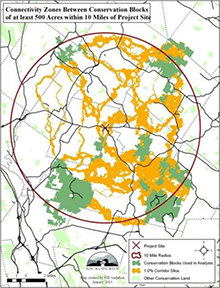Creating Tools to Support Integrated Transportation and Resource Planning in New Hampshire

GIS-based wildlife-connectivity model with conservation lands and connectivity zones. (Courtesy of
NHA)
New Hampshire Audubon
| Total cost: |
$48,939 |
| FHWA share: |
$24,464 |
| Period of performance: |
20 months |
| Dates: |
September 1, 2008 – April 30, 2010 |
| Status: |
Complete |
| AOTR: |
Dennis Durbin/Michael Lamprecht |
| Grant-project website: |
https://www.nhaudubon.org/ |
Project Goals
New Hampshire Audubon (NHA) developed a connectivity framework to integrate transportation and land-use planning for its Eco-Logical grant project. NHA intended for MPOs and Regional Planning Associations (RPAs) to use the model and framework for environmental screening of transportation projects before they submit their connectivity framework to New Hampshire DOT (NHDOT).
Project Activities and Accomplishments
NHA and the New Hampshire Fish and Game Department developed a GIS-based wildlife-connectivity framework to evaluate the impact of transportation projects on wildlife species. To create the model, NHA convened a working group with representatives from State and Federal agencies and conservation organizations. The working group developed an impact assessment framework that rated the resistance for 16 wildlife species by measuring how natural and unnatural barriers impacted the species’ abilities to move across the landscape. The analysis incorporated information on species proximity to traffic, riparian areas, land cover, and slope. As part of its outreach, NHA partnered with the Rockingham Planning Commission to apply the impact assessment framework to transportation projects. The dataset for the connectivity model is available on the NH Statewide GIS website for anyone with access to GIS software.
Future Steps
The New Hampshire Fish and Game Department will update the data for the connectivity model on an ongoing basis. NHA will continue to use the model in its work with local communities to improve wildlife protection through municipal planning ordinances and regulations. The Nature Conservancy will use the model for Staying Connected, a regional conservation project funded by the U.S. Fish and Wildlife Service, in partnership with State wildlife and transportation agencies and 11 other organizations.
Insights on Eco-Logical
While NHA has a long-standing relationship with State conservation agencies, the Eco-Logical grant program provided a new opportunity to initiate discussions with State and regional transportation planning staff. NHA has not yet been able to help NHDOT integrate wildlife data into transportation planning, perhaps due to limited capacity of NHDOT staff. Also, members of project working group had differing priorities for mapping and applying the species data, and participants did not fully reconcile their differences. This led to challenges when NHA tried to enlist transportation partners to apply the framework to transportation planning.
<< Return to Grant Projects

